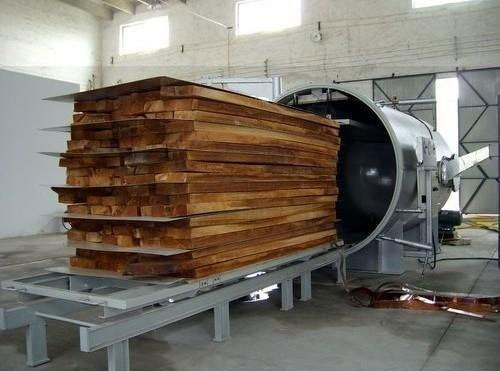Wood has been a cornerstone of human civilization for centuries, valued for its versatility, durability, and aesthetic attraction. However, not all wood is created identical, specifically with reference to its knowledge and treatment procedures.
Kiln-dried wood and thermo wood (or thermo modified wood) are famous forms of wood, each with its very personal distinct benefits and uses. If you’re in the market for wood, information on the difference between kiln-dried and thermo wood will help you in making a knowledgeable choice based on your particular needs.
What is Kiln-Dried Wood?
Wood that has been dried in a managed ecosystem using a kiln is called kiln-dried wood, kiln-dried logs, or absolutely kiln wood. In essence, the kiln is a large oven in which wood is heated to a high temperature and kept at a low humidity to lessen the amount of moisture within the wood. Depending on the size and thickness of the wood, the drying process may also take some days to several weeks.
Keeping the wood from bending, shrinking, or breaking at some stage in its natural drying process is the primary intention of kiln drying. This approach also makes it simpler to eliminate any fungus or insects that could be inside the wood, which makes it more secure to make use whilst growing furniture.
Benefits of Kiln-Dried Wood:
- Moisture Reduction: Kiln drying guarantees that the timber has a low moisture content material (normally between 6 and 8%). This makes the wood more solid and reduces the opportunity of it warping or cracking as quickly because it’s used in manufacturing or fixtures.
- Preservation: The warmth accomplished in the course of the kiln-drying manner kills pests, which include termites, larvae, and fungi; for this reason, it prolongs the lifespan of the wood.
- Strength and Durability: Kiln-dried wood is commonly stronger and extra long-lasting compared to air-dried wood. It’s additionally much less difficult to work with, because it’s a far more constant period and shape.
- Cost-Effective: Kiln drying is an extensively used and installed manner, making kiln-dried wood more low-cost as compared to distinct timber treatments.
What is Thermo Wood (Thermally Modified Wood)?
Thermo wood, moreover referred to as thermo wood or thermo-modified wood, is wood that has been treated through a high-temperature manner. Unlike kiln drying, which on the whole makes a forte of reducing moisture content in fabric, the thermo wood technique modifies the timber’s chemical form.
The wood is heated to temperatures between 160°C and 230°C in a controlled environment without using chemical substances. This system alters the wood’s cell shape, making it more solid, long-lasting, and resistant to moisture and decay.
The end result is a timber product that is absolutely proof against the factors, making it a first-rate choice for outside packages together with decking, siding, and landscaping. Thermo-modified wood is particularly famous in areas with high humidity or excessive weather situations.
Benefits of Thermo Wood:
- Enhanced Durability: The excessive temperatures used inside the thermo wood technique substantially beautify the timber’s resistance to moisture, decay, and pests. This makes it a definitely ideal desire for outside use, where timber is uncovered to harsh environmental conditions.
- Stability: Thermally modified wood is much more solid than regular untreated wood, which means it’s much less likely to warp, reduce back, or crack over time, even if exposed to modifications in temperature and humidity.
- Natural Preservation: Since the gadget does not incorporate the usage of chemical substances, thermo wood is taken into consideration as a greater environmentally friendly choice compared to different handled woods.
- Aesthetic Appeal: The heating method complements the timber’s herbal shade, giving it a rich, darkish hue which could add warmth and individuality to both indoor and outdoor areas.
- No Need for Chemicals: Unlike stress-dealt-with timber, thermally modified wood might now not require chemicals to make it proof against decay; it truly is a large draw for those looking for greater sustainable building substances.
Key Differences Between Kiln-Dried and Thermo Wood
While every kiln-dried wood and thermo wood go through warmth treatment techniques, their goals and results are pretty distinct. Here are a number of the critical differences among these sorts of wood:
| Aspect | Kiln-Dried Wood | Thermo Wood |
| Process | Removes excess moisture to prevent warping, cracking, or shrinking. Uses moderate heat and does not significantly alter the wood’s structure. | Undergoes high-temperature treatment (160°C-230°C), chemically modifying the wood for increased durability and resistance. |
| Moisture Content | 6-8% moisture content, making it stable and less likely to warp or crack. | Also has low moisture content but is more resistant to absorbing moisture, preventing swelling and shrinking. |
| Durability & Resistance | Stronger than air-dried wood but less resistant to decay, insects, and moisture compared to thermo wood. | Highly durable, resistant to decay, insects, and moisture—ideal for outdoor and high-humidity applications. |
| Environmental Impact | Requires significant energy but has a relatively low environmental impact compared to chemical treatments. | More environmentally friendly as it relies only on heat treatment, avoiding chemical use. |
| Aesthetic Appeal | Retains natural color and grain, but may fade over time due to moisture and sunlight exposure. | Develops a rich, darker color during treatment, enhancing its visual appeal, especially for outdoor settings. |
| Cost | More affordable due to a simpler drying process; widely available and cost-effective. | More expensive due to intensive processing, but its durability makes it a worthwhile investment for premium or outdoor projects. |
Which One Should You Choose?
The preference between kiln-dried timber and thermo timber relies upon the specific needs. If you’re seeking out a treasured, effective, and robust wood alternative for indoor furnishings, flooring, or well-known production, kiln-dried wood is a first-rate choice. It offers all the advantages of reduced moisture content material and balance, whilst additionally being extra price variety-pleasant.
On the other hand, in case you’re working on an outdoor task so you can be exposed to harsh weather situations, which includes decking, siding, or landscaping, thermo wood is a complicated preference. Its resistance to decay, moisture, and pests makes it best for outdoor applications, ensuring your wood stays long-lasting and aesthetically appealing for future years.
Both kiln-dried wood and thermo wood have their precise blessings. Understanding the differences will help you choose the right sort of wood for your subsequent challenge, whether or not it’s indoor or outdoor, residential or enterprise.
Conclusion
Kiln-dried wood and thermo wood both offer incredible benefits, depending on your specific wishes. Kiln-dried wood is an appropriate desire for most indoor projects wherein stability and moisture manipulation are essential.
In contrast, thermo wooden stands proud for its long-lasting sturdiness and resistance to the factors, making it the move-to alternative for outside programs. Both kinds of wood are incredible alternatives; however, information on their precise benefits will make certain you make the proper selection in your project.


